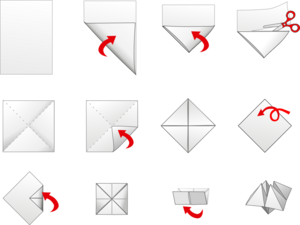Paper fortune teller facts for kids
A fortune teller is a fun paper game that kids often play. It's a type of origami, which is the art of paper folding.
This paper toy has different parts labeled with colors or numbers. A player chooses one of these options. Inside, there are eight secret flaps, and each one hides a message. The person holding the fortune teller moves it based on the player's choices. Finally, one of the hidden messages is shown. These messages might answer questions, or they could be fun activities for the player to do.
This same paper shape can also be used as pretend pincers or even a salt cellar. Many people also call it a cootie catcher. It has lots of other names too!
How to Make One
Making a paper fortune teller is quite simple. Here are the steps:
- Start with a square piece of paper. If your paper isn't square, fold one corner up to the opposite side. Then, cut off the extra paper to make a perfect square. You should now have diagonal creases.
- Next, fold all four corners of the square towards the very center. This creates a smaller square. This shape is sometimes called a "blintz base."
- Turn the smaller square over. Now, fold all four corners into the center again.
- Finally, fold all four corners up so their points meet in the middle. You will see pockets of paper in each of the four corners. Pull these pockets open and away from the center.
Playing with a Fortune Teller
To play, the person holding the fortune teller puts their fingers into the four corners. They keep two pairs of corners together and the other two pairs separated. This way, only half of the inside parts are seen. You can use your index fingers and thumbs from both hands, or a thumb and three fingers from one hand.
Here's how the game usually works:
- The player asks a question to the person holding the fortune teller. The fortune teller will "answer" this question.
- The holder then asks the player to pick a number or a color.
- Once the player chooses, the holder uses their fingers to switch between the two groups of colors and numbers inside the fortune teller.
- The holder moves the fortune teller a certain number of times. This number is usually based on the number chosen, or the number of letters in the color picked.
- After the holder finishes moving it, the player chooses one of the flaps that are now showing. These flaps often have colors or numbers on them.
- The holder then lifts that flap to show the secret message or "fortune" underneath! You can repeat these steps to keep playing.
Other Fun Uses
Besides telling fortunes, this paper shape has other cool uses:
- Catching Cooties: Kids sometimes use these shapes like little pincers. They pretend to catch imaginary bugs, like lice, which is why it's called a "cootie catcher."
- Salt Cellar: You can also place the fortune teller on a table with its four points facing down. The four open pockets can then hold small snacks or pieces of food.
Artists have also been inspired by this simple paper shape:
- In 1965, a special poem called "Frog pond plop (Opening 6)" by Sylvester Houédard was made into a paper fortune teller. It had words like "frog," "pond," and "plop" on its different parts.
- An Australian artist named Cassandra Laing created a large pencil drawing in 2007 called "Fortune Teller (it will all end in stars)." It showed hands holding a fortune teller with a space theme.
- A huge sculpture shaped like a paper fortune teller, called "Unfolding Lives," was made by Judith Forrest and Terri-ann White in 2010. It's in the Perth Cultural Centre in Australia and remembers children who were once in institutions. After being moved, it was put back near its original spot in 2023.
- In 2018, over 10,000 glowing red and yellow paper fortune tellers were used in an art display in Spain. It looked like lava pouring from a building!
- British artist Leonie Bradley's "Swarm" (2022) uses many yellow and black fortune tellers to look like a swarm of bees. People are invited to fold their own "bees" to think about choices and a positive future for our planet.
History of the Fortune Teller
The exact origin of the paper fortune teller isn't fully clear. Some historians think it might have come from Europe, not Japan, even though origami is often linked to Japan.
- In the 17th and 18th centuries, some baptism certificates in Central Europe were folded in a similar way to the base of a fortune teller.
- An origami historian named David Mitchell found many old European books from the 1800s that talked about a paper "salt cellar" or "pepper pot."
- The first clear picture of the paper fortune teller appeared in a German children's book in 1876.
- It was also mentioned in publications in New York and Europe in the 1880s and 1890s, still called a "salt cellar."
- In the 1950s, the use of this shape as a paper fortune teller became popular in England.
- Martin Gardner wrote about this fold in the 1950s, calling it both a bug catcher and a fortune teller.
- In the U.S., people started calling it a "cootie catcher" for paper games around the 1960s.
Besides "salt cellar," "fortune teller," and "cootie catcher," this origami shape has also been called a "bugcatcher," "chatterbox," "whirlybird," or "paku-paku." "Paku-paku" is a Japanese phrase that means "gobbling," and it's also the name of the famous video game character, Pac-Man!


